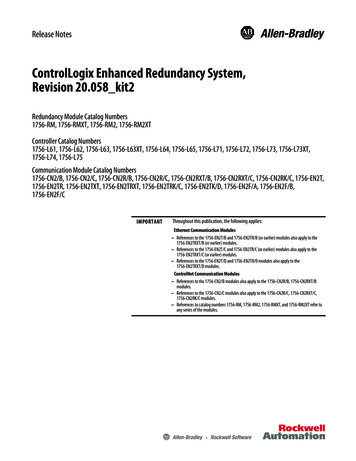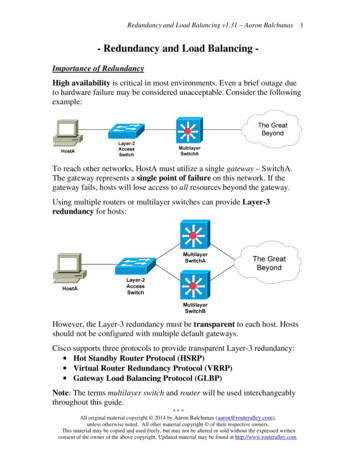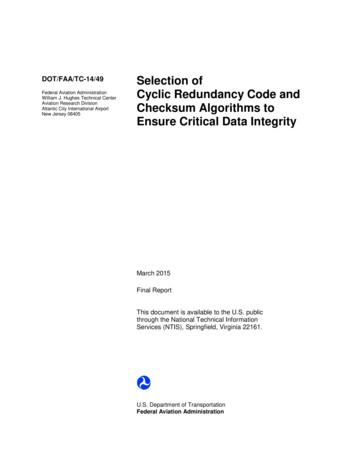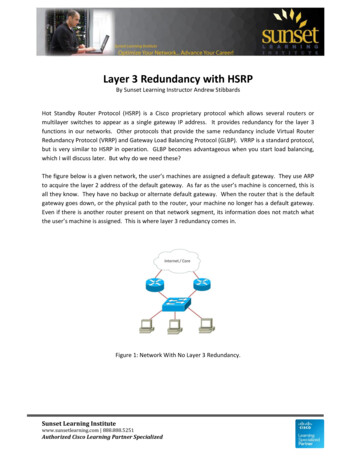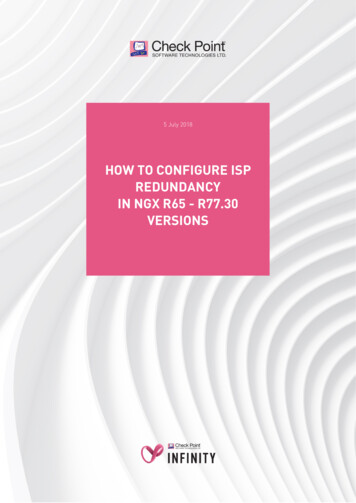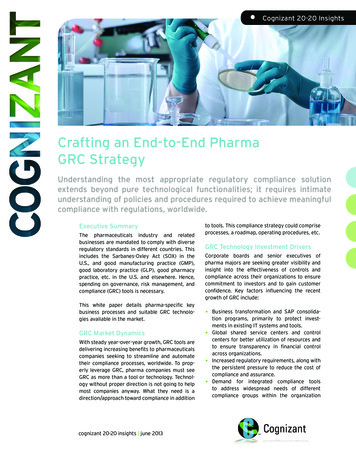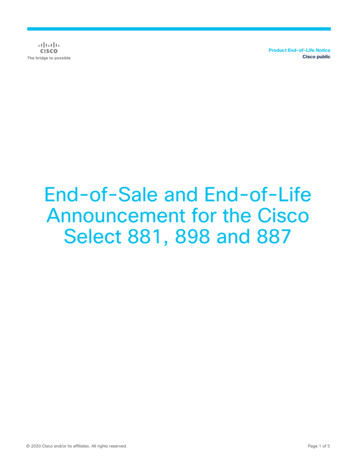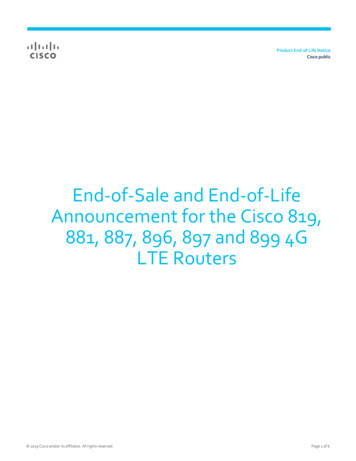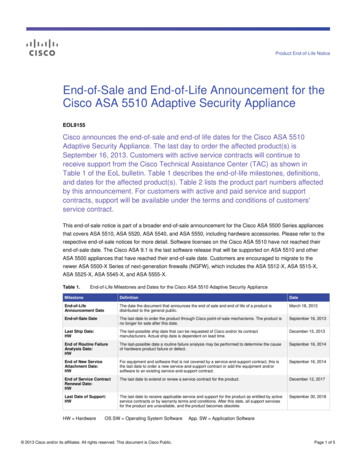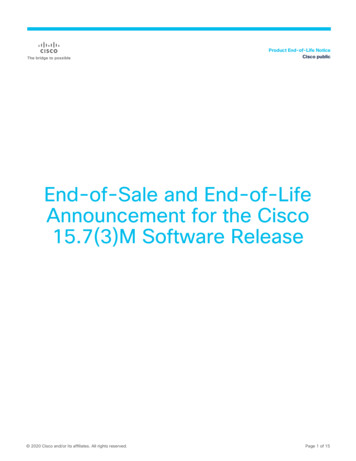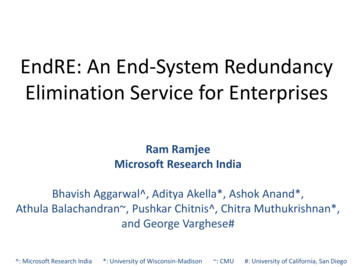
Transcription
EndRE: An End-System RedundancyElimination Service for EnterprisesRam RamjeeMicrosoft Research IndiaBhavish Aggarwal , Aditya Akella*, Ashok Anand*,Athula Balachandran , Pushkar Chitnis , Chitra Muthukrishnan*,and George Varghese# : Microsoft Research India*: University of Wisconsin-Madison : CMU#: University of California, San Diego
Enterprise Dilemma Large enterprises have a global footprint Data centers consolidated to save management cost Diminished performance due to Wide Area Network(WAN) bandwidth and latency constraints2
Middlebox-based WAN OptimizersData CenterEnterpriseSynchronized packet caches Protocol independent redundancy elimination usingsynchronized in-memory caches at two ends [Spring &Wetherall, Sigcomm 2000] Disk-based caches for large static objects Current leaders: RiverBed, Juniper, Cisco, Annual revenue 1Billion Are middleboxes the right approach for enterprises?3
Issues with MiddleboxesData CenterEnterprise1. End-to-end security and encryption–Either no RE or require key sharing2. Resource-constrained mobile smartphones–No RE on the bandwidth limited 2.5/3G wireless link3. Cost4
End-to-End RE: BenefitsData Center1.2.3.4.EnterpriseRE before encrypt End-to-end securityRE on mobiles Bandwidth savings over wirelessBandwidth savings simple decode Energy gainsOperate above TCP Latency gains5
Our ContributionsData CenterEnterprise1. EndRE Design– New SAMPLEBYTE fingerprinting for fast processing: 10X speedup– Optimized data structures for reducing memory overhead by 33-75%2. Evaluation of benefits– Analysis using 6TB of packet traces from 11 sites over 44 days– Small-scale deployment6
Outline OverviewDesign of EndREEndRE costs and benefitsSummary7
EndRE: Design Goals Opportunistic use of limited end host resources1. Fast and adaptive RE processing– Lightweight and tunable depending on server load2. Parsimonious memory usage– Data structure and design optimizations to reducememory overhead3. Asymmetric– Simple client decoding8
Redundancy Elimination: OverviewFingerprintinghash-table lookupsBandwidthconstrained linkpointerlookupsPacket cache (Synchronizedcircular buffer)Need to quickly identify repeated content ( 32 bytes)– Identifying all matches (optimal) impractical– Sampling-based approach necessary but comes at the cost ofmissed redundancy identification9
Redundancy Elimination: OverviewFingerprintinghash-table lookupsBandwidthconstrained linkpointerlookupsPacket cache (Synchronizedcircular buffer)1. Fingerprinting– Generate representative fingerprints of packet– New SAMPLEBYTE fingerprinting algorithm2. Matching & Encoding– Lookup fingerprints in a hash-table of cache fingerprints– Max-Match: Byte-by-byte comparison between cache & packet– Chunk-Match: Full chunk matches (see paper)10– Encode matched region with (position, length) tuples
1. Fingerprinting: MODP Compute fingerprints based on content [Spring & Wetherall]Packet payloadWindowRabin fingerprintingValue sampling: sample those fingerprints whose value is 0 mod p Robust to small changes in content better bandwidth savings– Rabin hashes expensive and not adaptive lower speed11
1. Fingerprinting: FIXED Fingerprints chosen at fixed intervals by position in the packet01 02 03 04 05 06 07 08 09 10 11 12 13 14 15 16 17Choose marker every p bytesHashw-byteHashw-byteHashw-byteFingerprints Simple selection criteria and tunable fast and adaptive– A small insertion/deletion in content will result in failure indetecting redundancy lower bandwidth savings12
1. Fingerprinting: SAMPLEBYTE Can we get the speed/adaptability of FIXED and the robustness ofMODP?7 4 6 0 0 0 8 5 0 1 1 5 0 6 7 0 0Choose marker if F(singlebyte) 1; e.g., F(0) 1, F(5) 1Once chosen, skip p/2 bytesHashw-byteHashw-byteHashw-byteFingerprints F(singlebyte) derived from training data using a greedy strategy Content-based bandwidth savings close to MODP? Simple selection & tunable skipping speed/adaptability of FIXED?13
2. Matching & Encoding: Max-Matchpayloadfingerprint1. Compute fingerprintsover fixed windows(e.g., 32bytes)2. Lookup in Fingerprint hash table Approach used inSpring & Wetherall– Meta data overhead is67% of cache size Collisions are not costly– Simple hash function– Overwrite hash table– No deletion Don’t store fingerprints!3. In case of match,expand regionFingerprint hash table Packet Cache– Use the table index toimplicitly representpart/all of fingerprint Meta data overhead is6-12% of cache size
Outline OverviewDesign of EndREEndRE costs and benefitsSummary15
Fingerprinting Algorithms: ComparisonMODPSAMPLEBYTEFIXED826724Bandwidth savings (%)Speed 03264128256Sampling period (p)5123264128256512Sampling period (p) SAMPLEBYTE delivers bandwidth savings similar to MODPwhile operating at speeds similar to FIXED16
10090807060504030201001009080706050403020100% of Servers% of ClientsEndRE Memory Requirements:44-day 11-enterprise Trace Analysis0100200300Maximum Cache Size at Client (MB)010002000Maximum Cache Size at Server (MB) Median/Max memory requirement at Client is 60/360MB Memory requirement at server tunable, at cost of reduced savings17
ImplementationHTTPSMBEndRE ManagementOTHERSBase Filtering Engine (BFE)WFP APIsuserALETDI/WSKStream LayerEndRE StreamLayer FilterTransport LayerNetwork LayerForward LayerADD FILTERADD CALLOUTkernelEndRE CalloutIPsecWFPFiltering EngineOther Callout modules EndRE pilot deployment on laptops/desktops over one week with 11users for HTTP traffic (1.7GB) delivered bandwidth savings of 31%18
Bandwidth Savings ( 2 raceSize(GB)17387158698080142198117100Middle(2GB)% savings7133344539343134442739EndREMiddleEndRE(1-10 MB) large-files large-files% savings %savings % 24030164626213030264134 EndRE delivers average bandwidth savings of 26-34%, asignificant portion of the 39-41% savings of middlebox19
Energy B (LZ)Energy% savingsBandwidth% 16841757076 ZLIB works well for large chunk sizes but on a packet-by-packetbasis may result in increased energy consumption20
Energy B (LZ)Energy% savingsBandwidth% 16841757076 EndRE’s bandwidth savings translate into equivalentsavings in energy with no additional latency21
Related work Static content (e.g., large files)– Host: Disk De-Duplication– Client and Server: LBFS (SOSP’01), RSYNC/RDC– Peer-to-Peer: DOT(NSDI’06), SET (NSDI’07), BranchCachein Win7 Dynamic content– Middlebox– Spring & Wetherall (SIGCOMM’00)– Products from Riverbed, Cisco, Juniper, etc. New architectures– Packet Caches: RE in routers (SIGCOMM’08)– Ditto: RE in wireless mesh networks (MobiCom’08)22
Summary1. EndRE– SAMPLEBYTE fingerprinting algorithm supports processingspeeds of 1.5-4Gbps/core– Data structure optimizations reduce server memory requirementby 33-75%2. Costs– Client processing negligible; Server processing is load adaptive;– Median client requires only 60MB of memory; Server up to 2GB3. Benefits– Avg. bandwidth savings of 26-34%– Bandwidth savings equivalent energy savings on smartphones EndRE is a promising alternative to WAN optimizers
Questions?
Middlebox-based WAN Optimizers Protocol independent redundancy elimination using synchronized in-memory caches at two ends [Spring & Wetherall, Sigcomm 2000] Disk-based caches for large static objects Current leaders: RiverBed, Juniper, Cisco, Annual revenue 1Bi
